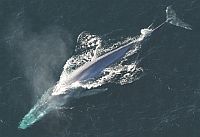 Despite being hunted from 1905–1971, the California blue whale has rebounded so that today it is approximately 97% of pre-whaling levels. The journal Marine Mammal Science recently published a study, “Do ship strikes threaten the recovery of endangered eastern North Pacific blue whales?” The analysis by the researchers from the University of Washington investigated why the observed increase in the whale population has slowed in recent years. They asked whether the cause might be ship strikes — whales being killed when hit by ships. They concluded that while ship strikes were too frequent, the reason that the rate of growth of the blue population has leveled off is because they have reached the capacity of the habitat to support them.
Despite being hunted from 1905–1971, the California blue whale has rebounded so that today it is approximately 97% of pre-whaling levels. The journal Marine Mammal Science recently published a study, “Do ship strikes threaten the recovery of endangered eastern North Pacific blue whales?” The analysis by the researchers from the University of Washington investigated why the observed increase in the whale population has slowed in recent years. They asked whether the cause might be ship strikes — whales being killed when hit by ships. They concluded that while ship strikes were too frequent, the reason that the rate of growth of the blue population has leveled off is because they have reached the capacity of the habitat to support them.
“The real key finding here is that they are close to recovery, which is a bit of a surprise. … Our perspective is that we’d rather there were no ship strikes at all, and they are over the legal limit,” said Dr. Trevor Branch in an interview with the BBC. “They have to do something to stop it, but 11 per year is so much lower than historic catches.”
Sadly, other blue whale populations around the world have not recovered from whaling. Why have the blue whales off California done better than blue whale populations around the globe? It may be because the North Pacific blue whales were not hunted extensively as in regions such as the Antarctic. California blue whale populations dropped to roughly 20% of pre-hunting levels whereas the Antarctic blue whales were hunted near extinction, to less than 1% of the original population level. The Antarctic blue whale was estimated in 1996 to be approximately 1,700 or was just 0.7% (0.3%–1.3%) of the pre-whaling level. The Antarctic population is growing at an annual rated of around 7% per year, but has a long way to go toward recovery. Likewise, the Chilean blue whale population is only around 8% of its pre-whaling levels.
While the rebound of the California blue whale population is good news, it is, in absolute terms, a relatively small group of whales. There are currently around 2,500 California blue whales. Before whaling there were an estimated quarter million blue whales in Antarctic waters.
At 30 metres (98 ft) long and weighing 170 tonnes (190 short tons) or more, blue whales are the largest animals on the planet and the heaviest ever to exist on the earth.
Thanks to Alaric Bond for contributing to this post.
